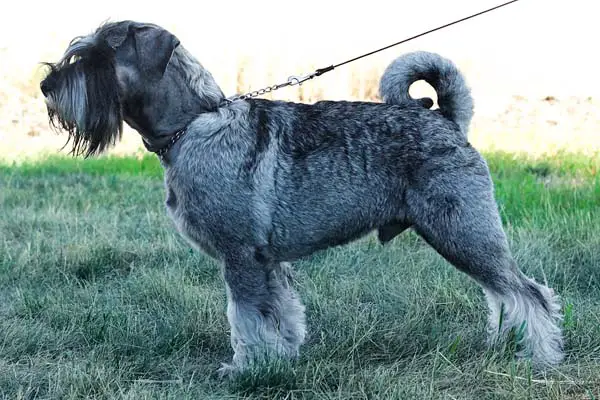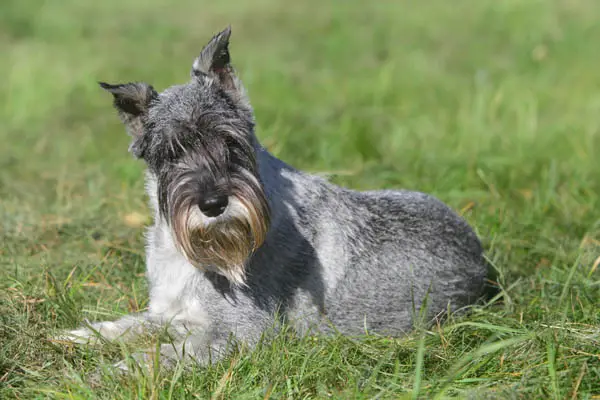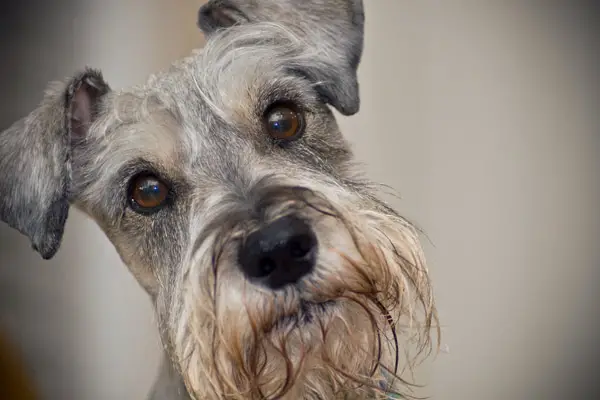Standard Schnauzers are medium-sized dogs that, as their name implies, the “standard” Schnauzer. They are larger than the Miniature Schnauzer and smaller than the Giant Schnauzer. And like both Schnauzer breeds, these dogs feature a wiry coat that comes in the colors of black or pepper and salt.
These dogs are known to be energetic and alert. Like the other Schnauzer breeds, they are also quick in movements and athletic. With the right owners, these dogs make excellent family companions, especially if they have smaller kids.

Standard Schnauzer Breed Statistics
| Dog Breed Group | Working |
| Breed Size | Medium |
| Height | 18.5-19.5 inches (male); 17.5-18.5 inches (female) |
| Weight | 35-50 pounds (male); 30-45 pounds (female) |
| Lifespan | 13-16 years |
Standard Schnauzer Breed Ratings
| Energy level | |
| Exercise needs | |
| Requires attention | |
| Playfulness | |
| Trainability | |
| Shedding | |
| Grooming | |
| Friendly with family | |
| Friendly with kids | |
| Friendly with strangers | |
| Friendly with other dogs | |
| Prey Drive |
Standard Schnauzer History
Standard Schnauzers came from Germany, where they were called Mittelschnauzer. They’re the first among Schnauzers’ breeds – the original which started the Giants and the Miniatures. These dogs are believed to have existed for centuries, as depicted in several paintings by Renaissance artists.
It is said that the Standards Schnauzers were developed by crossing a gray wolf spitz and a black German poodle. This resulted in a versatile dog that can guard farms and livestock, herd cattle, and get rid of pests. At the same time, these dogs are known to be great family companions.
By the mid-1800s, breeders started to standardize the breed. They were originally called Wirehaired Pinschers and were first exhibited in a dog show in Germany in 1879.
By 1900, the name Schnauzer became more familiar to people. Seven years later, in 1907, the Bavarian Schnauzer Klub in Munich, Germany, was founded. It was also around these times when the Schnauzers were imported to the US.
However, it was only in 1925 when the Schnauzer Club of America was formed. By 1933, the Standard Schnauzers were registered as separate by the American Kennel Club. Now, the breed ranks 89th as the most popular dog breed in the US.
Standard Schnauzer Temperament
The American Kennel Club generally describes standard Schnauzers as fearless, smart, and spirited. These dogs are dignified with impressive intelligence. Even their facial expressions already portray an alert, bold, and serious dog.
These dogs have high energies. Regardless if it’s indoors or outdoors, these dogs are quick and athletic. They love to play games with their humans, so they’re an excellent fit for those who can give them a lot of time.
As excellent family companions, the Standards Schnauzer is an affectionate and loyal dog. They make great playmates for your children and your other pets.
If there’s one thing you should note, don’t place this dog in a kennel or leave them in the backyard. They love being with their family, and as long as you have given him enough exercise, he won’t be much of a problem.
Standards Schnauzers are also known to be territorial dogs. You can expect them to bark to alert you when someone suspicious comes, however, they would never charge at people unless threatened.
They are just usually aloof to strangers. With early socialization, he’ll be more confident. This will also make him more well-rounded and accustomed to new things.
Training may come as a challenge because of their demanding and stubborn personalities. All you need is to establish firm and consistent leadership. If you can do that, he’ll be happy to oblige.

Care Requirements
- Nutrition: Standard Schnauzers don’t have special dietary requirements. All they need is to eat a high-quality and well-balanced meal daily. You can buy high-quality ingredients to serve as their food. The essential nutrients your dog will need are proteins, fats, carbohydrates, vitamins, and minerals. Animal meat such as beef, poultry, and fish are excellent sources of proteins. You can also add some fruits and vegetables to help in your dog’s digestion. If you don’t have time to prepare for your dog’s meal, then dog food should suffice. Just make sure to choose the premium quality ones to ensure that it’s free from fillers and additives.
- Grooming: The Standard Schnauzer’s coat sheds infrequently. But, the rugged and wiry nature of the coat requires regular brushing. The recommended frequency is at least 2-3 times a week, to ensure that tangles and mats would not form. This will also help remove any dirt stuck on their coat. Baths can be given occasionally or when only needed. You can also clip their coats to make it soft and lighter. Ears should be checked and cleaned regularly, though, to prevent ear infection. Nails should be kept as short as possible to keep your dog free from pain and discomfort.
- Exercise: Standard Schnauzers are energetic dogs who love play sessions, especially with their humans. These dogs require regular exercise, which can consist of daily walks or running around a secured fence. If you love the outdoors, you can take your Standard Schnauzer on a hike. You can also let them participate in canine sports where they can showcase their agility, herding, and lure coursing.
- Health: Standard Schnauzers are generally healthy dogs and are affected by only a very few health problems. This includes hip dysplasia, eye problems, pulmonic stenosis, hypothyroidism, hemophilia, and bladder stone. It’s essential to give them the right food and nutrition and keep them exercised for their bones to stay healthy. There are also screening tests available so we can detect any disease early. Regular check-ups may be needed too to monitor any changes in their behavior.
- Lifespan: The life expectancy of Standard Schnauzers is 13-16 years.

Fun Facts about Standard Schnauzers
- Standard Schnauzers originated from Germany back in the middle ages.
- They are the original Schnauzers; hence they’re called the “Standard.”
- These dogs began appearing in the US in the early 1900s.
- Standard Schnauzers also worked with the German army during the First World War.
- They were called Wirehaired Pinschers for four centuries.
